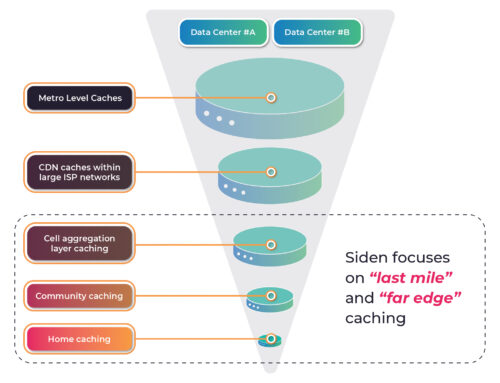Tech products are seldom built in a vacuum. Increasingly, standards are being used to foster interoperability of operational systems, and to develop system specifications in a collaborative manner. Company and industry alliances are also the order of the day, allowing companies to mutually benefit from knowhow built up within the ecosystem.
At Siden, we apply a similar approach. To describe Siden in a nutshell: Siden provides a “last-mile CDN” service, extending traditional CDN capabilities into the home. Siden enables popular OTT Video partners to leverage 1-6 TB of in-home cache storage for the most popular video content. Siden pre-populates each home cache with content targeted for that user (content the user is likely to watch in the near future). We deliver the content to the home cache using excess 4G/5G network capacity (not otherwise being used by regular traffic). User devices can then fulfill the majority of their popular OTT Video consumption needs over unconstrained, un-throttled home Wi-Fi.
Consistent with general industry practices, Siden mixes in standards with proprietary knowhow and technology to create a product that interworks seamlessly with other systems as needed, but also incorporates innovations that distinguish Siden’s service from other CDNs. We leverage standards where necessary, e.g. for interfacing with external systems (content providers, wireless networks), and our internally developed IP to address algorithms and proprietary functionality.
Standards-Essential vs. Non Standards-Based Functionality
Standards typically specify functionality essential to interoperability between systems. In fact, the terms “interoperable” and “standard” go hand-in-hand. In the wireless world, for example, communications protocols are defined, layer by layer, for most interfaces within the system. Thanks to clear standards-essential definition, my phone is able to communicate with any operational wireless network; this wouldn’t be possible otherwise.
Standards enable components developed by various vendors to interoperate seamlessly. In turn, this enables the network operator to scale their network easily, potentially mixing and matching components from different vendors. In contrast, if vendor implementations were to require customizations to interoperate, scalability would be next to impossible.
Standards also often specify test and certification procedures, e.g. within 3GPP in the cellular world and the Wi-Fi Alliance for Wi-Fi. This provides a stable reference ground to certify and help onboard vendor products as they get released. A mobile phone modem implementation, for example, has to pass a large number of stringent certification tests specified by 3GPP, before it can be released for use.
Having said all that, standards do leave sufficient room for proprietary (“non standards-essential”) innovations. Algorithmic functionality for things like scheduling, resource management etc. fall under the purview of vendor innovation. Vendors seek to differentiate their products via organically developed algorithms, optimized internal communications interfaces, and other related functionality. Solutions providers also differentiate at the product level, e.g. by providing innovative new features, superior product performance, reduced costs etc.
Siden with Standards & IP
Siden is active in the Streaming Video Technology Alliance’s (SVTA) Open Caching standardization initiative, specifically in the Home Storage Open Caching Node (HS-OCN) task groups. SVTA’s Open Caching has been building standards to define interoperable interfaces and procedures that CDN providers, content providers and other players in the content distribution space can leverage. These include interfaces (e.g. APIs) allowing content and CDN providers to interact with other CDN providers to configure and position content in various caching locations in the system, including network edge caches and home caches.
Siden has been an active participant in and contributor to this initiative. We are glad to lend our wealth of knowhow and experience in wireless-integrated CDN development to help make this standard whole and usable by interested stakeholders. As with most standards, the Open Caching initiative seeks to define the standards-essential components of a content distribution system, e.g. interfaces and procedures for routing of content requests by clients, configuration of caches at different locations, querying about caching locations and cache availability, content placement within caches, and related functionality.
The standards leave the door open for product level innovation. Siden’s extensive R&D in this area has driven our differentiating product features, in areas such as: algorithms for smart targeting of content to cache locations, content delivery scheduling schemes, optimal use of wireless network excess capacity to carry out the “last-mile” delivery of content, intelligent use of broadcast / multicast capabilities in networks for spectrally efficient content delivery, etc. We have covered all these proprietary smarts with adequate patent protection – granted patents as well as applications in the pipeline.
Additionally, at Siden, we have been tracking the standardization efforts in 3GPP and industry alliances such as Open-RAN. Our interest in 3GPP is predominantly 5G – specifically aspects related to CDN integration with 5G networks, QoS provisioning for different traffic tiers, network slicing etc. A specific 5G topic of interest is the ongoing 5G Multicast Broadcast Service (5G MBS or 5MBS) standardization. This is the 5G version of eMBMS or LTE-B. Standardization work started in 2020, and is very much ongoing. 5MBS is of long-term interest to us, given that use of multicast / broadcast capabilities is an integral part of Siden’s system design.
Narayan
Wireless Technology





